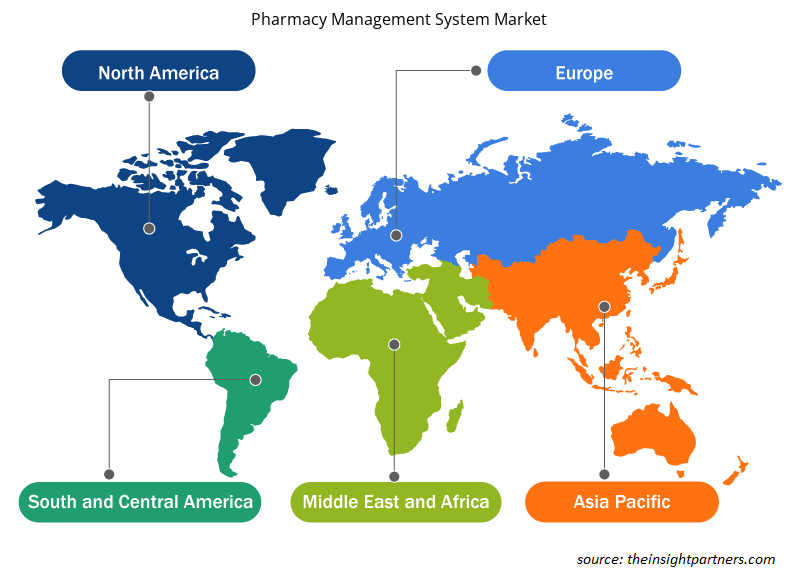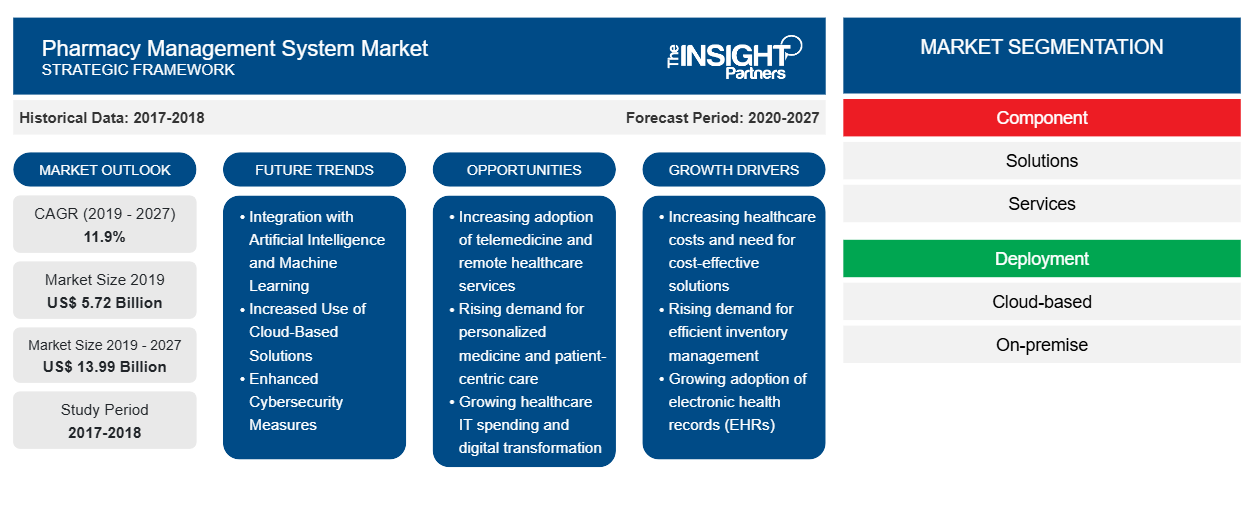薬局管理システム市場は2019年に57億2,482万米ドルと評価され、2027年までに139億8,527万米ドルに達すると予測されており、2020年から2027年にかけて11.9%のCAGRで成長すると予想されています。
薬局管理システムは、強力で使いやすい薬局管理システムを備えた重要なツールです。薬局管理システムは、薬剤師が薬の調剤、薬の在庫、POS機能の複雑さに対処するのに役立ちます。また、処方された薬や医薬品をより高いセキュリティ、精度、効率で処理、追跡、調剤するのに役立ちます。薬局管理システム市場の成長は、ヘルスケアITの発展に起因しており、世界中の薬局の数の増加が長年にわたって市場の成長を後押しすると予想されています。ただし、薬局管理システムに関連する制限は、今後数年間の市場の成長にマイナスの影響を与える可能性があります。
薬局管理システム市場は、パンデミック後に大幅な成長が見込まれています。COVID-19は、ロックダウン、渡航禁止、事業停止により、さまざまな国の経済や産業に影響を及ぼしています。COVID-19危機は多くの国の公衆衛生システムに過度の負担をかけ、医療システムへの持続可能な投資の必要性を浮き彫りにしました。COVID-19パンデミックが進行するにつれて、ヘルスケア業界の成長は低下すると予想されます。ライフサイエンスセグメントは、体外診断製品の需要増加と世界的な研究開発活動の増加により繁栄しています。しかし、医療技術およびイメージングセグメントは、実施される手術数の減少と機器調達の遅延または長期化により、売上が減少しています。さらに、医療専門家による仮想相談は、パンデミック後の主流のケア提供モデルになると予想されています。遠隔医療がケアの提供を変革するにつれて、デジタルヘルスは今後数年間繁栄し続けるでしょう。さらに、臨床試験の中断とそれに伴う医薬品の発売の遅れにより、将来的には完全にバーチャルな試験が行われるようになることも予想されます。mRNA などの新しい技術が登場し、製薬業界や市場を変革することが予想され、今後数年間で垂直統合や合弁事業がさらに進むことも予想されます。
要件に合わせてレポートをカスタマイズする
このレポートの一部、国レベルの分析、Excelデータパックなど、あらゆるレポートを無料でカスタマイズできます。また、スタートアップや大学向けのお得なオファーや割引もご利用いただけます。
- このレポートの主要な市場動向を入手してください。この無料サンプルには、市場動向から見積もりや予測に至るまでのデータ分析が含まれます。
市場分析
ヘルスケアにおける薬局管理システムの応用拡大が薬局管理システム市場の成長を促進
世界のほとんどの国で、医療費は着実に増加しています。これらの国の医療分野の発展には複数の要因が寄与していることが判明しており、この分野での情報技術 (IT) の応用に関する一貫した急速な発展が大きな要因となっています。過去数十年にわたり、情報技術は数百万人の人々の労働に重要な役割を果たし、医療を含むさまざまな産業分野の向上に貢献してきました。多くのエンドユーザー、処方者、薬剤師が自動化のメリットを享受しています。IT ソリューションの使用により、患者の記録を構造化された形式で保存できるようになりました。また、電子処方の実装を標準化するのにも役立ち、大量の紙を節約し、投与と薬剤の調剤のプロセスを簡素化し、サプライ チェーンの下での医薬品の取り扱いを自動化しました。最終的には、患者の安全性を向上させ、患者が医薬品を最大限に活用できるように高品質のケアを提供するのに役立っています。
世界中の政府機関は、薬剤師の独自のスキルとITの実装を最大限に活用するために、現在の伝統的な薬局を再形成するためのさまざまな行動計画を取り入れています。たとえば、ニュージーランドのウェリントンの保健省は、新しい薬局管理システムを使用して薬局が提供するさまざまな新しい高度なサービスを説明した薬局行動計画2016〜2020を導入しました。さらに、在庫およびリポジトリ管理のデジタル化と自動化により、ウォールグリーン、アポロ、CVSなどの大規模な薬局チェーンの供給プロセスが合理化されました。したがって、ヘルスケアITのこのような進歩は、今後数年間、薬局管理ソリューション市場の成長を促進し続けると予想されます。
一人当たりの薬局数は世界的に急増しています。経済協力開発機構(OECD)によると、OECD諸国における薬局と薬剤師の総数は2000年から2015年の間に30%増加しました。先進国の中で、日本は、医師による薬の処方箋と薬剤師による薬の調剤への依存をなくし、薬剤師の利益率を高め、国内の医薬品と医療用品の数を増やすという、調剤分離に向けた政府の取り組みにより、薬剤師密度が最も高くなっています。薬局数の増加傾向はオーストラリアでも見られます。オーストラリア薬剤師組合2017年版およびIBIS 2018年版によると、過去5年間と比較して、2018年には医薬品給付制度(PBS)の収益が30.6%増加し、薬局の設立数が6%増加しました。
薬局数の増加は、医薬品や医薬品の売上増加、高齢化の進行、処方薬プログラムの実施の増加、特許切れの増加による新しいジェネリック医薬品の市場への道の開拓、患者人口における新たな疾患発生率の上昇に起因しています。
これにより、医薬品や医薬品の需要が増加し、新しい薬局の設立や既存の薬局チェーンの拡大につながっています。技術の進歩により、新しく設立された薬局は、薬局管理システムなどのスマートな管理ツールを導入し、流通プロセスを簡素化および高度化しています。
コンポーネントベースの洞察
コンポーネント別に見ると、薬局管理システム市場はソリューションとサービスに分かれています。ソリューションセグメントは2019年に市場で最大のシェアを占めました。
展開ベースの洞察
導入に基づいて、薬局管理システム市場はクラウドベースとオンプレミスに区分されます。オンプレミスセグメントは、2019 年に市場で最大のシェアを占めました。
サイズベースの洞察
薬局管理システム市場は、規模によって中小規模の薬局と大規模薬局に分かれています。2019年には大規模薬局セグメントが市場で最大のシェアを占めました。
薬局管理システム市場のプレーヤーは、世界中で変化する顧客の需要に応えるために製品の発売と拡大の戦略を採用しており、これにより世界的にブランド名を維持することも可能になります。
薬局管理システム市場の地域別洞察
予測期間を通じて薬局管理システム市場に影響を与える地域的な傾向と要因は、Insight Partners のアナリストによって徹底的に説明されています。このセクションでは、北米、ヨーロッパ、アジア太平洋、中東、アフリカ、南米、中米にわたる薬局管理システム市場のセグメントと地理についても説明します。

- 薬局管理システム市場の地域別データを入手
薬局管理システム市場レポートの範囲
| レポート属性 | 詳細 |
|---|---|
| 2019年の市場規模 | 57億2千万米ドル |
| 2027年までの市場規模 | 139.9億米ドル |
| 世界のCAGR(2019年 - 2027年) | 11.9% |
| 履歴データ | 2017-2018 |
| 予測期間 | 2020-2027 |
| 対象セグメント | コンポーネント別
|
| 対象地域と国 | 北米
|
| 市場リーダーと主要企業プロフィール |
|
薬局管理システム市場のプレーヤー密度:ビジネスダイナミクスへの影響を理解する
薬局管理システム市場は、消費者の嗜好の変化、技術の進歩、製品の利点に対する認識の高まりなどの要因により、エンドユーザーの需要が高まり、急速に成長しています。需要が高まるにつれて、企業は提供内容を拡大し、消費者のニーズを満たすために革新し、新たなトレンドを活用し、市場の成長をさらに促進しています。
市場プレーヤー密度とは、特定の市場または業界内で活動している企業または会社の分布を指します。これは、特定の市場スペースに、その規模または総市場価値と比較して、どれだけの競合相手 (市場プレーヤー) が存在するかを示します。
薬局管理システム市場で事業を展開している主要企業は次のとおりです。
- マッケソンコーポレーション
- セルナーコーポレーション
- BD
- ゼネラル・エレクトリック・カンパニー
- オールスクリプツヘルスケア LLC
免責事項:上記の企業は、特定の順序でランク付けされていません。

- 薬局管理システム市場のトップキープレーヤーの概要を入手
薬局管理システム市場 – コンポーネント別
- 解決
- 在庫管理
- 発注管理
- サプライチェーンマネジメント
- 規制およびコンプライアンス情報
- 臨床および管理パフォーマンス
- その他のソリューション
- サービス
薬局管理システム市場 – 導入別
- クラウドベース
- オンプレミス
薬局管理システム市場 – 規模別
- 中小規模の薬局
- 大型薬局
薬局管理システム市場 – 地域別
北米
- 私たち
- カナダ
- メキシコ
ヨーロッパ
- フランス
- ドイツ
- イタリア
- 英国
- スペイン
- その他のヨーロッパ
アジア太平洋(APAC)
- 中国
- インド
- 韓国
- 日本
- オーストラリア
- その他のアジア太平洋地域
中東・アフリカ(MEA)
- 南アフリカ
- サウジアラビア
- アラブ首長国連邦
- MEAの残り
南米と中央アメリカ(SCAM)
- ブラジル
- アルゼンチン
- 残りの詐欺
企業プロフィール
- マイクロソフト
- フィリップスNV
- インテルコーポレーション
- ゼネラル・エレクトリック・カンパニー
- アルファベット株式会社
- NVIDIA コーポレーション
- ニュアンスコミュニケーションズ株式会社
- シーメンス ヘルシナーズ AG
- 株式会社アルテリス
- ジョンソン・エンド・ジョンソン・サービス株式会社
- 過去2年間の分析、基準年、CAGRによる予測(7年間)
- PEST分析とSWOT分析
- 市場規模価値/数量 - 世界、地域、国
- 業界と競争環境
- Excel データセット


- GNSS Chip Market
- Single Pair Ethernet Market
- Vision Care Market
- Retinal Imaging Devices Market
- Emergency Department Information System (EDIS) Market
- Personality Assessment Solution Market
- Explosion-Proof Equipment Market
- Parking Management Market
- Aircraft Landing Gear Market
- Integrated Platform Management System Market

Report Coverage
Revenue forecast, Company Analysis, Industry landscape, Growth factors, and Trends

Segment Covered
This text is related
to segments covered.

Regional Scope
North America, Europe, Asia Pacific, Middle East & Africa, South & Central America

Country Scope
This text is related
to country scope.
よくある質問
Despite accuracy, speed, safety, and management benefits provided by pharmacy management systems, factors such as consolidation and carry forward of manually entered incorrect data, downtime due to software failure, and lack of compatibility between systems offered by different manufacturers are among the major limitations associated with these systems.
Pharmacy management system is an important tool equipped with powerful and user friendly pharmacy management services. These systems assist pharmacist in managing complex tasks such as dispensing medicines, inventory management, and point of sales functions.
The demand for pharmacy management system is expected to grow at a significant pace during the forecast period. Some of the prime factors propelling the growth of the market include increasing investment in healthcare IT infrastructure worldwide, demand to enhance patient safety, emerging pharmacy business and rise in health expenditure in developing countries.
Trends and growth analysis reports related to Technology, Media and Telecommunications : READ MORE..
The List of Companies - Pharmacy Management System Market
- McKesson Corporation
- Cerner Corporation
- BD
- General Electric Company
- Allscripts Healthcare, LLC
- Epicor Software Corporation
- Talyst LLC (Swisslog Healthcare)
- OMNICELL INC.
- ACG Infotech Ltd.
- Clanwilliam Health
The Insight Partners performs research in 4 major stages: Data Collection & Secondary Research, Primary Research, Data Analysis and Data Triangulation & Final Review.
- Data Collection and Secondary Research:
As a market research and consulting firm operating from a decade, we have published and advised several client across the globe. First step for any study will start with an assessment of currently available data and insights from existing reports. Further, historical and current market information is collected from Investor Presentations, Annual Reports, SEC Filings, etc., and other information related to company’s performance and market positioning are gathered from Paid Databases (Factiva, Hoovers, and Reuters) and various other publications available in public domain.
Several associations trade associates, technical forums, institutes, societies and organization are accessed to gain technical as well as market related insights through their publications such as research papers, blogs and press releases related to the studies are referred to get cues about the market. Further, white papers, journals, magazines, and other news articles published in last 3 years are scrutinized and analyzed to understand the current market trends.
- Primary Research:
The primarily interview analysis comprise of data obtained from industry participants interview and answers to survey questions gathered by in-house primary team.
For primary research, interviews are conducted with industry experts/CEOs/Marketing Managers/VPs/Subject Matter Experts from both demand and supply side to get a 360-degree view of the market. The primary team conducts several interviews based on the complexity of the markets to understand the various market trends and dynamics which makes research more credible and precise.
A typical research interview fulfils the following functions:
- Provides first-hand information on the market size, market trends, growth trends, competitive landscape, and outlook
- Validates and strengthens in-house secondary research findings
- Develops the analysis team’s expertise and market understanding
Primary research involves email interactions and telephone interviews for each market, category, segment, and sub-segment across geographies. The participants who typically take part in such a process include, but are not limited to:
- Industry participants: VPs, business development managers, market intelligence managers and national sales managers
- Outside experts: Valuation experts, research analysts and key opinion leaders specializing in the electronics and semiconductor industry.
Below is the breakup of our primary respondents by company, designation, and region:

Once we receive the confirmation from primary research sources or primary respondents, we finalize the base year market estimation and forecast the data as per the macroeconomic and microeconomic factors assessed during data collection.
- Data Analysis:
Once data is validated through both secondary as well as primary respondents, we finalize the market estimations by hypothesis formulation and factor analysis at regional and country level.
- Macro-Economic Factor Analysis:
We analyse macroeconomic indicators such the gross domestic product (GDP), increase in the demand for goods and services across industries, technological advancement, regional economic growth, governmental policies, the influence of COVID-19, PEST analysis, and other aspects. This analysis aids in setting benchmarks for various nations/regions and approximating market splits. Additionally, the general trend of the aforementioned components aid in determining the market's development possibilities.
- Country Level Data:
Various factors that are especially aligned to the country are taken into account to determine the market size for a certain area and country, including the presence of vendors, such as headquarters and offices, the country's GDP, demand patterns, and industry growth. To comprehend the market dynamics for the nation, a number of growth variables, inhibitors, application areas, and current market trends are researched. The aforementioned elements aid in determining the country's overall market's growth potential.
- Company Profile:
The “Table of Contents” is formulated by listing and analyzing more than 25 - 30 companies operating in the market ecosystem across geographies. However, we profile only 10 companies as a standard practice in our syndicate reports. These 10 companies comprise leading, emerging, and regional players. Nonetheless, our analysis is not restricted to the 10 listed companies, we also analyze other companies present in the market to develop a holistic view and understand the prevailing trends. The “Company Profiles” section in the report covers key facts, business description, products & services, financial information, SWOT analysis, and key developments. The financial information presented is extracted from the annual reports and official documents of the publicly listed companies. Upon collecting the information for the sections of respective companies, we verify them via various primary sources and then compile the data in respective company profiles. The company level information helps us in deriving the base number as well as in forecasting the market size.
- Developing Base Number:
Aggregation of sales statistics (2020-2022) and macro-economic factor, and other secondary and primary research insights are utilized to arrive at base number and related market shares for 2022. The data gaps are identified in this step and relevant market data is analyzed, collected from paid primary interviews or databases. On finalizing the base year market size, forecasts are developed on the basis of macro-economic, industry and market growth factors and company level analysis.
- Data Triangulation and Final Review:
The market findings and base year market size calculations are validated from supply as well as demand side. Demand side validations are based on macro-economic factor analysis and benchmarks for respective regions and countries. In case of supply side validations, revenues of major companies are estimated (in case not available) based on industry benchmark, approximate number of employees, product portfolio, and primary interviews revenues are gathered. Further revenue from target product/service segment is assessed to avoid overshooting of market statistics. In case of heavy deviations between supply and demand side values, all thes steps are repeated to achieve synchronization.
We follow an iterative model, wherein we share our research findings with Subject Matter Experts (SME’s) and Key Opinion Leaders (KOLs) until consensus view of the market is not formulated – this model negates any drastic deviation in the opinions of experts. Only validated and universally acceptable research findings are quoted in our reports.
We have important check points that we use to validate our research findings – which we call – data triangulation, where we validate the information, we generate from secondary sources with primary interviews and then we re-validate with our internal data bases and Subject matter experts. This comprehensive model enables us to deliver high quality, reliable data in shortest possible time.


 このレポートの無料サンプルを入手する
このレポートの無料サンプルを入手する